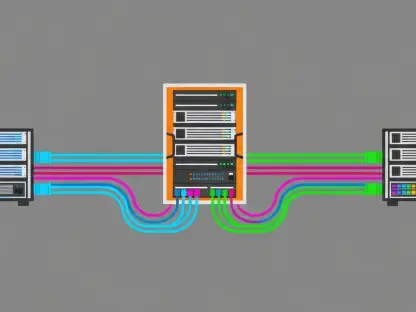In an era where every second counts, the ability to process and analyze data almost instantly has become a cornerstone of business success, revolutionizing how organizations respond to challenges and seize opportunities in a fast-paced world. Real-time analytics, once a futuristic vision, now empowers companies to make informed decisions within moments, whether it’s catching fraudulent transactions, tailoring customer interactions, or streamlining operations. This technology’s rapid evolution, fueled by artificial intelligence (AI) and cutting-edge platforms, is reshaping industries from retail to manufacturing. As businesses strive to stay competitive in a data-driven world, the integration of instant insights into everyday operations marks a profound shift in strategic thinking. This article explores the journey of real-time analytics, its synergy with AI, and its expanding role as a fundamental tool across diverse sectors, shedding light on why it has become indispensable for modern enterprises aiming to thrive.
The Evolution and Democratization of Real-Time Analytics
From Niche to Mainstream
The transformation of real-time analytics from a specialized, resource-heavy endeavor to a core element of business infrastructure reflects a significant shift in organizational priorities over recent years. Initially, harnessing data in real time required custom engineering and substantial investment, limiting its use to large enterprises with deep pockets. However, the landscape has changed dramatically as market studies indicate a sharp decline in standalone projects, with a growing emphasis on embedding these capabilities into broader data architectures. This integration allows companies to align real-time insights with overarching digital strategies, ensuring that data isn’t just fast but also actionable across multiple touchpoints. The move away from isolated initiatives underscores a recognition that competitive edges are now built on seamless, system-wide intelligence rather than fragmented speed.
Accessibility to real-time analytics has surged thanks to advancements in cloud-native platforms and open-source technologies such as Apache Kafka and Apache Flink, which have dismantled traditional barriers. These tools enable low-latency data pipelines, making it feasible for organizations of varying sizes to process information at unprecedented speeds without exorbitant costs. Smaller businesses, once sidelined by technical and financial constraints, can now leverage these solutions to compete with industry giants. The proliferation of user-friendly frameworks and scalable cloud environments means that expertise in complex data engineering is no longer a prerequisite, broadening the adoption of real-time capabilities. This democratization ensures that instant data analysis isn’t just a luxury for the few but a practical asset for many, reshaping how industries approach innovation and responsiveness.
Breaking Down Technical Barriers
The role of technology in leveling the playing field for real-time analytics cannot be overstated, as cloud computing continues to simplify the deployment and management of data systems. Platforms built on flexible, scalable architectures allow businesses to handle diverse workloads, from high-frequency data writes to intensive reads, without the need for custom infrastructure. Open-source solutions like Apache Cassandra and ClickHouse further reduce dependency on proprietary software, offering cost-effective alternatives that maintain high performance. This shift has empowered mid-tier companies and startups to experiment with real-time applications, fostering a culture of agility and experimentation that was once out of reach for many.
Moreover, the rise of managed services in the cloud has alleviated the burden of maintaining complex data pipelines, enabling teams to focus on deriving value rather than wrestling with technical overhead. Training programs and community-driven resources around these technologies have also grown, equipping a wider workforce with the skills to implement real-time analytics effectively. The result is a vibrant ecosystem where innovation thrives, as businesses can quickly adapt tools to their unique needs. This newfound accessibility not only accelerates adoption but also encourages cross-industry collaboration, driving forward-thinking solutions that redefine operational norms.
The Power of AI and Real-Time Synergy
Beyond Speed to Intelligence
The intersection of real-time analytics with AI marks a pivotal evolution, shifting the focus from merely rapid data processing to generating predictive insights and automated outcomes. Businesses are no longer content with quick reactions; instead, they seek systems that anticipate trends and execute decisions with minimal human oversight. This trend reflects a deeper understanding that true advantage lies in intelligence, not just velocity, as AI algorithms analyze streaming data to uncover patterns and forecast scenarios in moments. Such capabilities are transforming how enterprises tackle challenges, enabling proactive strategies that outpace reactive measures. The fusion of these technologies is setting a new benchmark for efficiency, where the value of data is measured by its ability to drive foresight rather than just inform the present.
This strategic pivot is evident in the way organizations across sectors harness AI to amplify real-time analytics, tailoring solutions to specific pain points with remarkable precision. In consumer markets, for instance, AI-powered systems detect anomalies like fraud in milliseconds, safeguarding transactions while enhancing user trust. Meanwhile, industrial applications leverage predictive maintenance models to preempt equipment failures, minimizing downtime based on live data feeds. These examples highlight how the synergy between AI and real-time processing creates smarter ecosystems, reducing reliance on manual intervention. As companies continue to refine these integrations, the emphasis on intelligent automation signals a future where data doesn’t just inform but actively shapes outcomes across diverse domains.
Applications Across Sectors
In consumer-facing industries, real-time analytics paired with AI has refined use cases like dynamic pricing and personalized recommendations, delivering tailored experiences at scale. Retailers and e-commerce platforms analyze customer behavior as it happens, adjusting offers and suggestions to maximize engagement and revenue. Fraud detection systems, similarly, rely on instantaneous data scans to flag suspicious activities, protecting both businesses and users from financial losses. These applications demonstrate how the technology ensures consistency, whether serving the first customer or the millionth, by embedding real-time insights into the fabric of digital interactions. The result is a seamless, responsive experience that has become a baseline expectation in today’s market.
Industrial sectors, on the other hand, are witnessing a revolution as real-time analytics drives autonomous operations with data rooted in current conditions rather than historical trends. In energy and manufacturing, for instance, sensors feed live metrics into systems that optimize resource allocation and predict operational hiccups before they escalate. This immediacy enables precise adjustments, enhancing safety and efficiency in environments where delays can be costly. Life sciences and chemical industries also benefit, using real-time data to monitor processes and ensure compliance with stringent standards. The versatility of these applications underscores the technology’s capacity to address complex, sector-specific needs, proving its value as a universal tool for progress.
Real-Time Analytics as a Standard Expectation
Embedded in Business Operations
As real-time analytics becomes woven into the fabric of business tools, its presence is no longer viewed as an innovative add-on but as a fundamental requirement, particularly for enterprises focused on customer engagement. The expectation is clear: applications must deliver consistent, personalized experiences regardless of user volume, relying on instantaneous data to maintain quality. From recommendation engines in streaming services to risk analysis in financial platforms, the ability to process information on the spot ensures that interactions remain relevant and timely. This integration blurs the distinction between cutting-edge technology and routine functionality, as companies embed real-time capabilities directly into their operational frameworks, making them invisible yet indispensable to end users.
The shift toward viewing real-time analytics as a standard feature reflects a broader cultural change in how businesses prioritize data-driven excellence over isolated technological feats. Customer 360 initiatives, which aim to provide a holistic view of user interactions, depend heavily on live data to offer a unified experience across channels. This capability isn’t just about keeping pace but about setting a new norm where delays in insight are unacceptable. As industries adapt, the seamless incorporation of real-time processing into everyday systems highlights a maturing market where responsiveness is synonymous with reliability. Such expectations are reshaping vendor offerings, pushing developers to prioritize embedded analytics as a core component of their solutions.
Future Potential with AI Agents
Looking toward the horizon, industry experts anticipate that real-time analytics will play a central role in powering AI assistants and agents, particularly in contexts demanding swift, autonomous responses over the coming decade. These advanced systems are expected to handle complex queries and execute decisions in real time, leveraging live data to support industries like energy and healthcare where precision and speed are paramount. The vision is one of AI-driven entities acting as operational partners, using real-time insights to navigate intricate challenges without human input. This progression promises to elevate the technology’s impact, turning raw data streams into strategic tools that redefine efficiency and innovation.
The potential for AI agents to transform industrial and operational landscapes through real-time analytics is immense, as they enable environments where machines and systems communicate and adapt instantly. In manufacturing, for instance, such agents could orchestrate entire production lines based on live feedback, optimizing output while minimizing waste. Similarly, in emergency response scenarios, AI assistants could analyze unfolding data to coordinate resources with unparalleled accuracy. This forward-looking integration suggests a future where real-time analytics isn’t just a facilitator but a catalyst for autonomous ecosystems, driving progress in ways that were once unimaginable. Reflecting on past advancements, the strides made in embedding this technology have laid crucial groundwork for these emerging possibilities.









